MXA RACE TEST: THE REAL TEST OF THE 2023 KAWASAKI KX450SR “SPECIAL RACER”
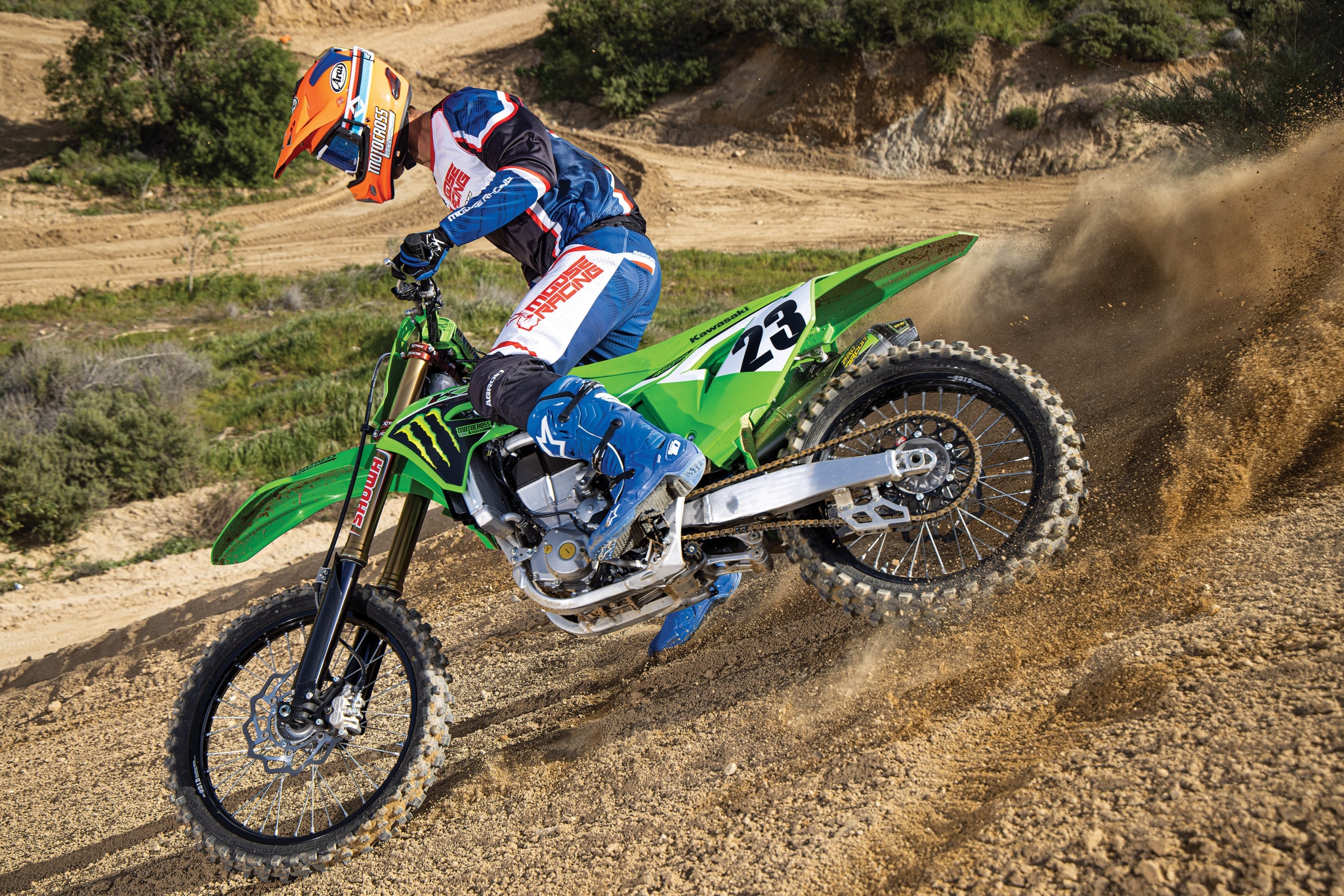 The Kawasaki KX450SR model is a modified KX450 with a $12,699 price tag that you can buy straight from your dealer. That’s $3000 more than the stock KX450. THE GEAR: Jersey: Moose Racing Agroid, Pants: Moose Racing Agroid, Helmet: Arai VX-Pro4, Goggles: Viral Brand Signature Series, Boots: Alpinestars Tech 10.
The Kawasaki KX450SR model is a modified KX450 with a $12,699 price tag that you can buy straight from your dealer. That’s $3000 more than the stock KX450. THE GEAR: Jersey: Moose Racing Agroid, Pants: Moose Racing Agroid, Helmet: Arai VX-Pro4, Goggles: Viral Brand Signature Series, Boots: Alpinestars Tech 10.
Q: IS THE 2023 KAWASAKI KX450SR BETTER THAN THE 2022 MODEL?
A: It depends on who you ask. If you like stiffer suspension, then yes. If you prefer plush settings, then no. The 2023 KX450SR is almost the exact same bike; the only switch-up is that Kawasaki went from Kayaba to Showa suspension. We loved the handling of last year’s KX450SR. It worked well for a wide range of riders. But, the new model didn’t give away too much—and still results in a bike that is much better than the stocker.
Q: WHAT’S THE DIFFERENCE BETWEEN KAWASAKI’S AND KTM’S “FACTORY EDITION” BIKES?
A: KTM started the Factory Edition trend and proved that there’s an audience who’s willing to pay an upcharge for a new “stock” bike with aftermarket parts already on it. However, Austria’s philosophy is a little different from Kawasaki’s and Honda’s. The KTM, Husky and GasGas Factory Edition models offer a preview of what’s to come on their new stock bike in the following year, while Kawasaki’s KX450SR and Honda’s CRF450 Works Edition are simply modified stock bikes.
KTM and Husqvarna have often rolled out next year’s chassis and engines on the Factory Editions. Most recently, the 2022-1/2 Factory Edition models were exact replicas of what would be the 2023 KTMs and Huskys—months ahead of the actual 2023 model introduction. Kawasaki does have an all-new KX450 coming out in 2024, and anyone who’s paying attention to the Kawasaki factory MXGP team has seen the prototype version of the bike already, ridden by Romain Febvre and Mitch Evans. However, this 2023 KX450SR isn’t a preview of that model; it’s just a 2023 bike with mods.
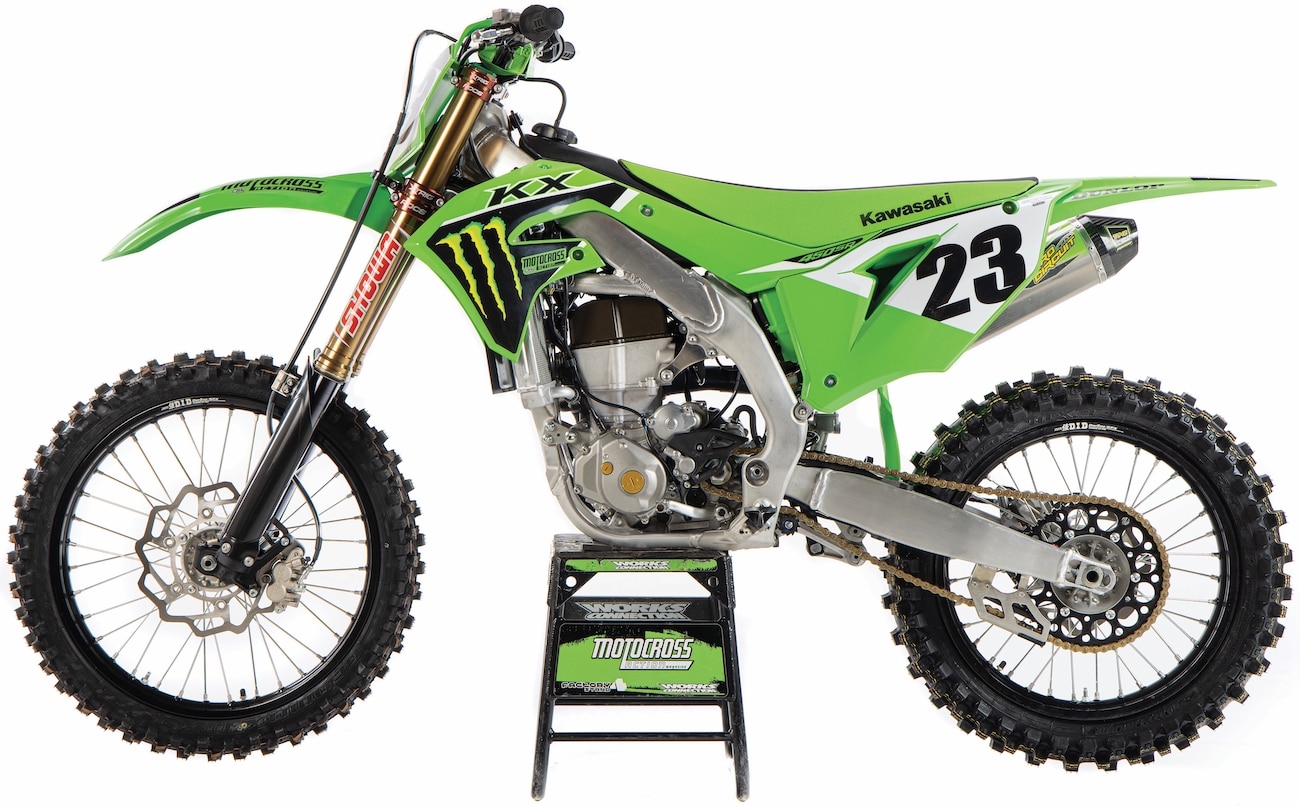 The most significant change on the 2023 KX450SR Special Racer is the swithc from last year’s Kayaba forks to Showa forks.
The most significant change on the 2023 KX450SR Special Racer is the swithc from last year’s Kayaba forks to Showa forks.
Q: WHAT’S THE DIFFERENCE BETWEEN THE KX450 “SPECIAL RACER” AND THE STOCK 2023 KAWASAKI KX450?
A: This might not be a preview of the 2024 model, but we certainly aren’t complaining about the 2023 KX450SR. It comes with an impressive list of upgrades. Here is a quick list of the ten major updates that Kawasaki made to the KX450SR.
(1) New for 2023, the KX450SR is spec’ed with Showa front and rear suspension components. The new Showa forks have titanium-oxide-coated inner fork tubes that resist wear and reduce friction. The large 49mm fork tubes are the same size as found on Kawasaki’s factory race bikes and allow for the use of large 39mm compression-damping pistons and a 25mm cartridge cylinder. The inner surface of the outer fork tubes features Showa’s Dimplush texture, which has a wave-like finish to help retain an oil film for smoother action. The Dimplush texture also has a Kashima coating to create a low-friction surface that helps prevent wear, so the sliding surfaces remain smooth for a long time. Plus, a Showa rear shock replaces last year’s Kayaba unit.
(2) The KX450SR is equipped with a complete Pro Circuit Ti-6 Pro titanium exhaust system, not just an aftermarket muffler like KTM and Husqvarna.
(3) The ECU fuel-injection mapping has been refined to work with the Pro Circuit exhaust and reworked cylinder head.
(4) The cylinder head features a ported and polished intake tract. Everything is cleaned up to a bright, shiny finish. We pulled it apart to check Kawasaki’s work and can confirm they aren’t fibbin’.
(5) The forged-aluminum 2023 Kawasaki triple clamps have been replaced by billet-machined Xtrig ROCS (revolutionary opposing clamp system) triple clamps with PHDS (Progressive Handlebar Damping System) bar mounts.
(6) The “Kawasaki Racing Team”-engraved billet-machined Hinson clutch cover holds a larger volume of oil; however, it’s only a Hinson cover, and the rest of the clutch is stock.
(7) The subframe has been reinforced where it has been prone to breaking under the weight of the stock KX450 muffler.
(8) A D.I.D ERT3 gold chain runs on a black-anodized Renthal rear sprocket.
(9) The KX450SR comes with the race team’s Monster Energy race-team-inspired graphics.
(10) The Kawasaki marketing department points out that the KX450SR comes with D.I.D DirtStar ST-X rims, but a quick check of the stock 2023 KX450 reveals that the same black-anodized D.I.D 66-09-14 rims are used on both; the only difference is the white D.I.D DirtStar STX logo. 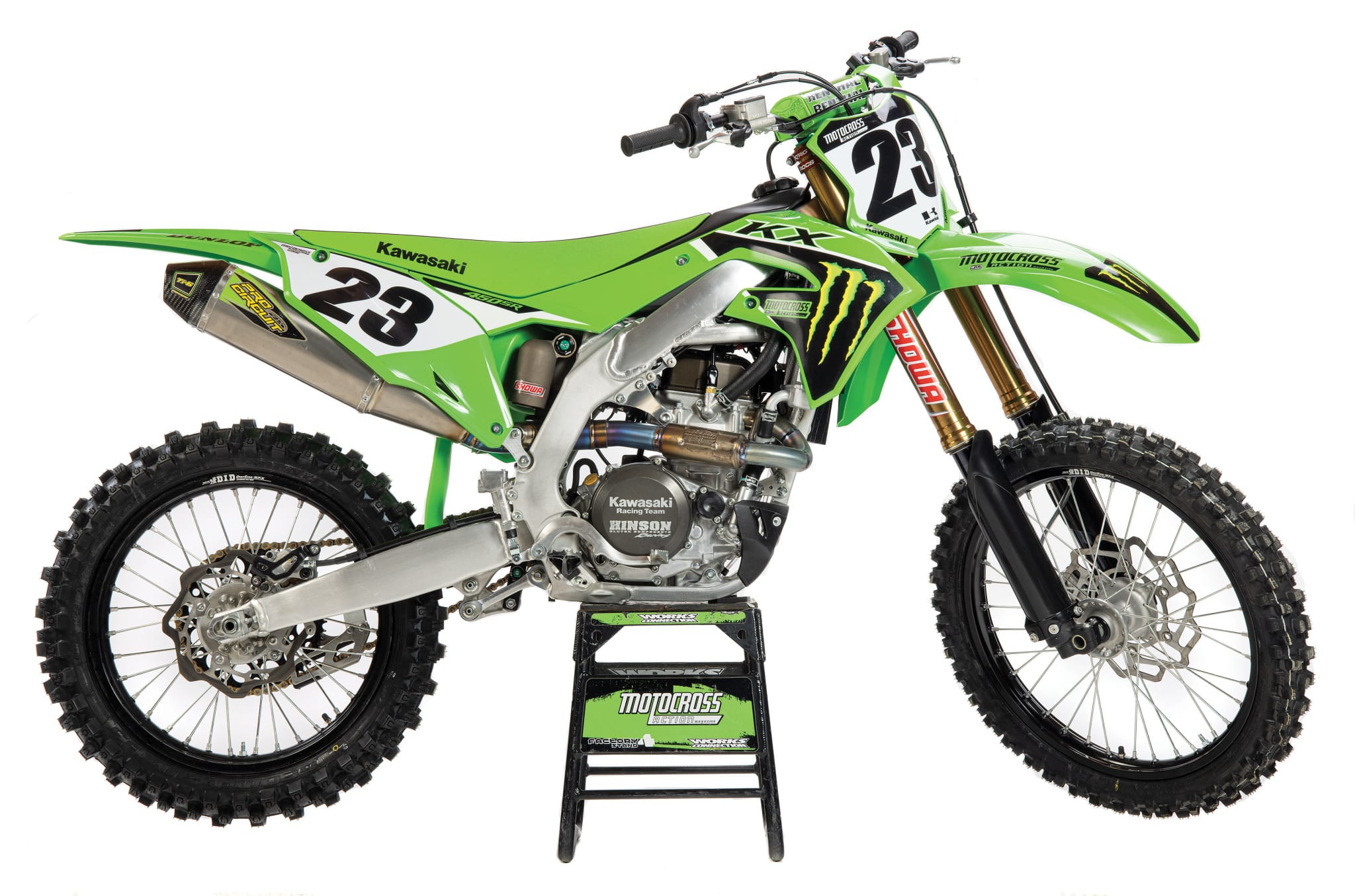 Q: IS THE $12,699 PRICE TAG WORTH IT?
Q: IS THE $12,699 PRICE TAG WORTH IT?
A: The price-tag question is a sensitive one. As motorcycle prices rise, fewer riders are able to afford new bikes. However, there are riders who can afford the latest and greatest, and they are the ones buying Honda, Kawasaki, KTM, Husqvarna and GasGas special editions (Yamaha makes special editions, but the mods are limited to black plastic and Monster logos).
At $12,699, the KX450SR could be considered worth the upcharge, but only if you don’t plan to switch out the Pro Circuit exhaust for FMF, the Xtrig triple clamps for Luxon or the black box for a Twisted Development Vortex ignition. The retail price for buying a stock 2023 Kawasaki KX450 ($9599), plus a full Pro Circuit titanium exhaust system ($1270), Xtrig ROCS triple clamps ($850), re-valved and resprung Showa forks ($750), and a remapped ECU ($299 at Twisted Development for the mapping and $1000 for the Vortex), adds up to just $12,620. And, that doesn’t count the polished head, fork coatings, Hinson clutch cover, reinforced subframe, D.I.D gold chain or aftermarket Renthal rear sprocket.
The catch-22 of the 2023 KX450SR is that if you want a different pipe, triple clamps, ignition, graphics or suspension settings, you are better off buying the stock model and making your own mods in due time.
Q: HOW DID THE 2023 KAWASAKI KX450SR RUN ON THE DYNO?
A: It blew our socks off! Well, maybe that’s an exaggeration, because we had already seen these same dyno numbers on last year’s 2022 KX450SR, but the numbers are still impressive.
The stock 2023 Kawasaki KX450 ranks fifth in peak horsepower, beating the Suzuki RM-Z450 by 1.5 horsepower and the Honda CRF450 by a very slim 0.06 horsepower. Needless to say, the stock 56.3-horsepower Kawasaki KX450 isn’t at the top of the 2023 pony-producing totem pole. It’s up against the 59.9 KTM 450SXF, 59.4 Husqvarna FC450, 58.9 Yamaha YZ450F, and 57.1 GasGas MC450F.
What blew our socks off is that Kawasaki KX450SR was able to use the Pro Circuit exhaust, touched-up intake tract and remapped ECU to hit a class-leading 60.5 horsepower (a gain of 4.2 horsepower over the 2023 production engine). Amazingly, the power is still linear like the stock KX450 as well. The stock bike is slow at peak power when you’re racing down the start against the other 450s, but it feels fast on the track because of how snappy it is on the bottom end.
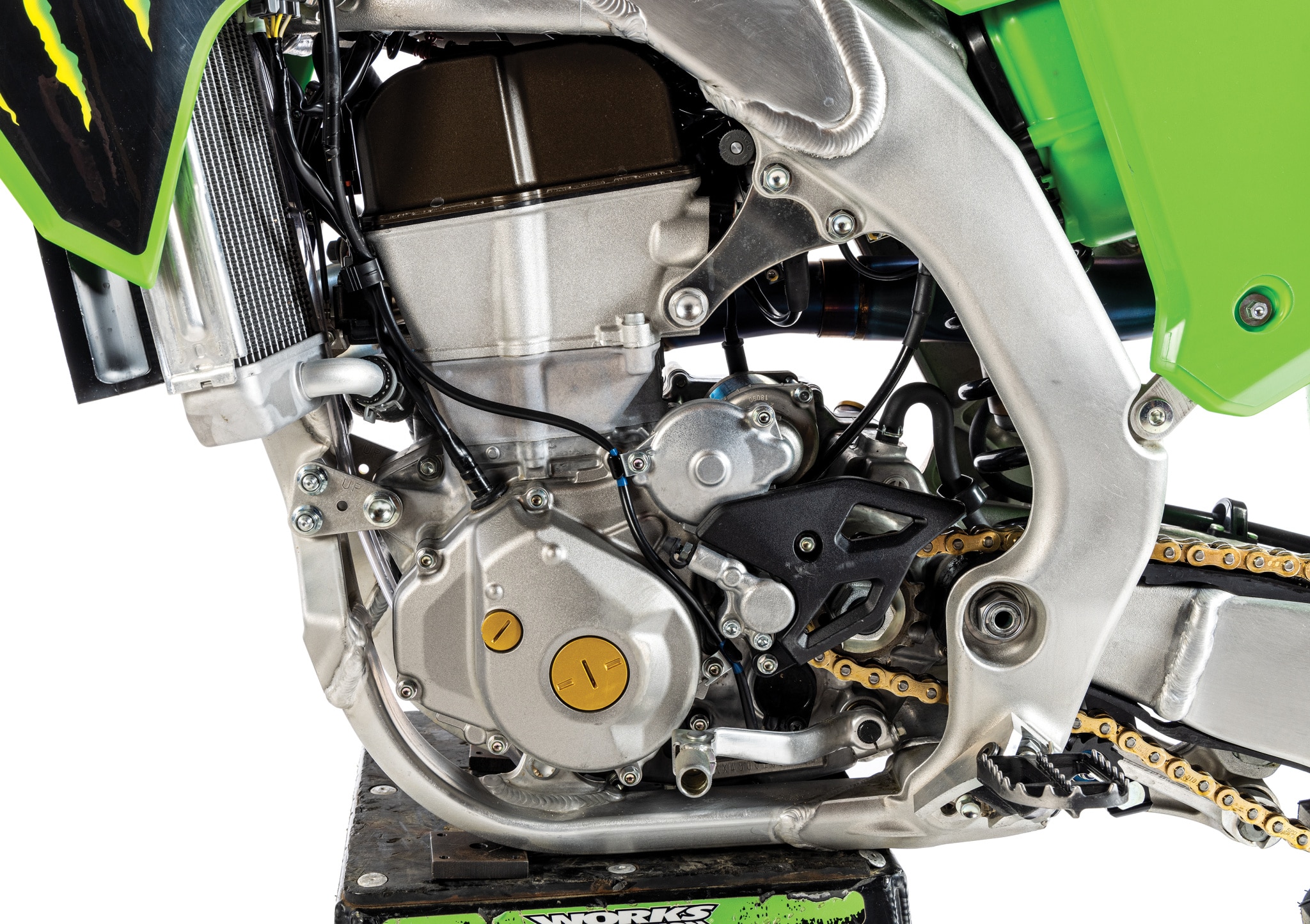 The KX450SR engine makes an extra 4 horsepower, thanks to a touched-up intake tract, Pro Circuit exhaust and updated ECU mapping.
The KX450SR engine makes an extra 4 horsepower, thanks to a touched-up intake tract, Pro Circuit exhaust and updated ECU mapping.
Q: HOW DOES THE KX450SR MAPPING WORK?
A: One knock against Kawasaki is that they don’t have a handlebar-mounted map switch to allow the rider to switch between maps on the fly. Instead, you have the old-school black (mellow), white (aggressive) and green (stock) couplers to switch out. A second knock against the electronics is the Kawasaki FI calibration tool (used to customize your own map settings) costs $700. This wouldn’t be a big deal if Yamaha didn’t offer their WiFi-connecting GYTR Power Tuner app for free, with all of the same capabilities—and more.
Interestingly enough, the couplers don’t actually hold information inside of them; the three maps are already saved in your bike’s ECU brain. The couplers simply work as conductors to tell your ECU which map to use. This means that if you lose your black KX450SR coupler, you can take one off your KX250 or stock KX450 and it’ll work the same, accessing the specific maps that were created for the KX450SR.
Q: HOW DOES THE KX450SR RUN ON THE TRACK?
A: Every MXA test riders loved this engine. The stock 13/50 gearing ratio creates great shift points. The KX450SR doesn’t feel like a 60.5-horsepower engine because it’s smooth. The rest of the horsepower and torque curve is very linear, making it easy to ride fast. Also, the Pro Circuit Ti-6 exhaust system is loud, making the bike sound like Jason Anderson’s factory KX450.
Naturally, the KX450SR is snappy and free-revving on the bottom end. Even the 56-horsepower stock KX450 is known for its lively bottom-end snap that makes the bike feel faster than it is. To mellow out the initial punch, the black (mellow) coupler worked great. When making the first 180-degree left-hand turn to go up Glen Helen’s very steep Mt. Saint Helen, the mellow map helped us put power to the ground easier without pulling a huge wheelie.
Comparatively, the aggressive (white) map offered even more snap on the bottom end, making it easy to blip the throttle to hop over bumps in the rough stuff, but harder to keep the front wheel on the ground on corner exits. For racing, most of our test riders leaned towards the mellow map because it smoothed out the initial snap while maintaining the strong midrange and fast 60-horsepower top end. As for the standard (green) map, it fits perfectly in between the two. Snappy and strong on the bottom end, but not as aggressive as the white coupler.
Q: WHY DID KAWASAKI GET RID OF THE KAYABA SUSPENSION?
A: It was very interesting when Kawasaki rolled out the KX450SR in 2022 with Kayaba suspension on it. The stock KX450 came with Showa components, and Adam Cianciarulo (Eli’s teammate in ’20 and ’21) and Jason Anderson have been were using Showa works suspension. Why would Kawasaki spec Kayaba components on their “Special Racer” model when it was supposed to mimic the race team’s bike, which didn’t use Kayaba components? The answer is somewhat perplexing. In 2022, Eli Tomac had the Kawasaki race team outfit his race bike with Kayaba suspension. And, since Kawasaki had planned to release the original KX450SR as an “Eli Tomac Edition” bike, they got caught with their pants down when Eli signed with Yamaha for 2022. Of course, the pencil-pushers at Kawasaki had been working on the “Eli Tomac Edition” of the KX450SR for months and were too invested in the Kayaba components at the time to change suspension horses mid-stream. Thus, the 2022 KX450SR came with Kayaba forks and shock in 2022 and Showa in 2023.
How weird was it to have Kayaba on the KX450SR last year? Not all that weird. Kawasaki uses Kayaba suspension for their KX250 model, and even Ryan Villopoto used Kayaba suspension in his early years with the Monster Energy Kawasaki team before he switched to Showa components in 2013. One more Showa/Kayaba note: Although Kayaba components are stock on the KX250, the Pro Circuit Kawasaki KX250 team uses Showa.
Initially, we were sad to see the Kayaba components go. We loved the way the 2022 KX450SR handled last year. The settings were perfect for Intermediate riders, comfortable for Vets and still manageable enough for Pros.
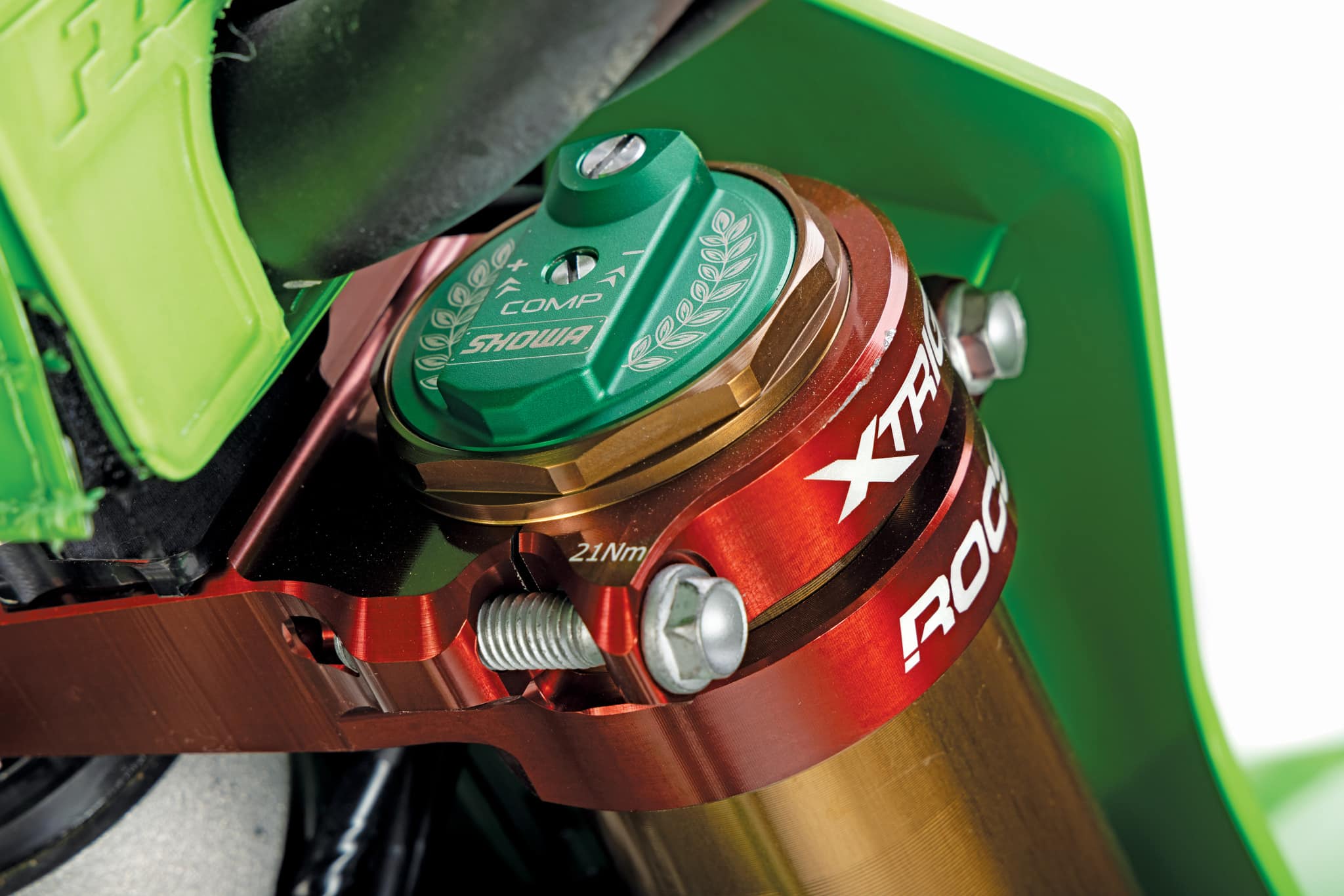
Q: HOW IS THE SHOWA SUSPENSION ON THE TRACK?
A: The new Showa suspension looks ultra-trick with its coated fork tubes and the fancy green fork caps. In motion, we expected it to be on the soft side since the stock KX450 suspension valving is ultra-soft and the 2023 KX450SR forks use the same 5.0 N/mm spring rate—that was not the case. The new Showa fork and shock have considerably more hold-up than last year, making them better for faster riders. Our Pro-level test riders left the forks in their stock settings and went out on the high-speed compression on the shock to get the rear end to settle a little more to take some weight off the front end. They even went softer on the compression, something that Pros don’t normally do with stock suspension.
Although the new suspension is stiffer, don’t worry too much. The Showa forks are still progressive, starting out plush on top and getting stiffer as they go. The SR-specific Showa forks do top out easily, and you can feel the clanking in the handlebars when they do.
Q: HOW DOES THE KX450SR HANDLE ON THE TRACK?
A: We’ve always appreciated the Kawasaki KX450 for its comfortable aluminum chassis and consistent handling. The majority of our handling complaints have been focused on the ultra-soft stock suspension settings that are seemingly made for 140-pound kids. Once you fix the suspension, though, the KX450 is a great bike that’s stable at speed while still having decent accuracy at corner entrances. The 2023 KX450SR is certainly stiffer than the Kayaba-equipped 2022 KX450SR, and it’s a huge step ahead of the featherweight setup that comes on the stock KX450.
One challenge with the KX450SR (and stock KX450) is the 250mm rear brake rotor. We have no idea why Kawasaki hasn’t switched to the 240mm rotor that comes stock on the KX450X cross-country bike and the KX250 models. If they have the parts in stock, and use it on other models, why wouldn’t they put it on the KX450 and KX450SR? The 250mm rotor is overkill and in a bad way.
One might ask, what’s the problem with having a surplus of brake power? Can’t you just press down on it less? Yes, Sherlock, you’re right, but the point is that it’s better if you don’t have to. Because the rear brake is so strong, it upsets the bike, locks up the rear wheel and is too grabby. On our 2022–’23 KX450, we installed the 240mm rotor and rear caliper carrier off the KX250. It makes for a much smoother ride.
The Xtrig ROCS triple clamps are a nice touch as well, but the PHDS bar mounts aren’t our favorite. “PHDS” stands for “Progressive Handlebar Damping System,” which adds some comfort, but comes at the price of a taller handlebar height. To compensate, we’ll run lower handlebars or switch to the lighter and lower Xtrig fixed bar mount.

Q: WHAT DID WE HATE?
A: The hate list:
(1) Radiator cap. You’d think it would be cheap insurance and better for the company’s overall image to run a high-pressure-rated radiator cap to reduce coolant loss and protect the engine from overheating. We run a 2.0 kg/cm2 Twin Air Ice Flow radiator cap.
(2) Plastic. The Kawasaki fork guards are brittle, and they’ll crack when roosted. To prevent this issue and protect your forks, replace them with Acerbis fork guards, or put graphics on your stock guards to hold them together.
(3) Rear brake. The 250mm rear brake rotor is way too grabby, and it upsets the chassis in turns.
(4) Levers. For some reason, the front brake and clutch levers don’t match. They’re both skinny, and they have different shapes. We also wish we could adjust the reach on the levers easier. On the Austrian bikes, you turn a knob to set the lever distance from your fingers. On Kawasaki, you need an 8mm wrench to do it.
(5) Chain roller. The lower chain roller falls apart quickly.
(6) Chain slap. For some reason (maybe the same reason the fork guards crack), Kawasaki’s chain guide makes more noise than any other stock dirt bike out there. It rattles like crazy. Order a TM Designworks Slide-n-Glide kit as soon as you wear the stock one out.
(7) Threads. The 8mm bolt on the left-side number plate, which has to be removed every time you change an air filter, strips easier than any other bolt in motocross. Keep beginner mechanics away from this bolt.
(8) Seat bolt. The T-plates that attach the 10mm seat bolts to the rear fender fall out easily. After having to pick the T-plates up off the ground a few dozen times, we ordered Bolt Hardware’s replacement T-plates.
Q: WHAT DID WE LIKE?
A: The like list:
(1) Power. The KX450SR engine works like a dream. We have no complaints about it.
(2) Mapping. We wish we could switch maps on the fly, but we’re still thankful to have three distinct map options with the plug-in couplers.
(3) Ergonomics. The Kawasaki KX450 is narrow and easy to move around on. Plus, you can lower the stock footpeg mounts to get more extension (for tall guys) and lower your center of gravity when standing.
(4) Clutch. Although the new clutch isn’t perfect, it is much better than what they had before. The Belleville washer design was borrowed from KTM.
(5) Suspension. The Showa components on the KX450SR are 10 steps ahead of the stock 2023 KX450 suspension.
(6) Weight. At 233-1/2 pounds, the KX450SR is a half pound lighter than the stock KX450, a half a pound heavier than the 2023 YZ450F and CRF450 models, 4-1/2 pounds heavier than the KTM and Husky, and 11-1/2 pounds heavier than the 2023 GasGas MC450F.
(7) Tires. The Dunlop MX33 tires are great.
(8) Chain. We trust the D.I.D ERT3 gold chain and are thankful to have it on this bike.
(9) Subframe. Although we haven’t broken any subframes on our KX450 test bikes, our friends who own KX450s have. It cracks at the muffler mount. It’s nice to have a reinforced subframe on the SR model, but it’s a slap in the face to regular KX450 buyers when Kawasaki knows about this issue and they don’t fix it on their stock bike.

Q: WHAT DO WE REALLY THINK?
A: Overall, the Kawasaki KX450 platform is great, and with the SR’s minimal intake-tract touch-up, Pro Circuit exhaust and updated mapping, the engine runs with the best in class. The ergonomics are comfortable and even adjustable to make the tall guys happy. However, durability issues always leave us with a bad taste in our mouth.
MXA’S 2023 KAWASAKI KX450SR SETUP SPECS
This is how we set up our 2023 Kawasaki KX450SR for racing. We offer it as a guide to help you find your sweet spot.

SHOWA COIL-SPRING FORK SETTINGS
The stock 2023 KX450’s Showa forks are way too soft. We had to run either one 5.0 fork spring with a 5.2 in the other leg or two 5.2 springs. Thankfully, Showa went much stiffer on the internal valve settings for the KX450SR model, giving these forks a chance to hold up. These are the numbers we ran on the 2023 Kawasaki KX450SR for hardcore racing:
Spring rate: 5.0 N/mm
Compression: 12 clicks out
Rebound: 12 clicks out
Fork-leg height: 0mm
Notes: If you don’t think the KX450SR is turning as well as it should, slide the forks up in the triple clamps to put more weight on the front wheel and steepen the head angle.
SHOWA SHOCK SETTINGS
The Showa shock was easy to set up. We recommend this shock setup on the 2023 Kawasaki KX450SR:
Spring rate: 54 N/mm
Hi-compression: 1-1/4 turns out
Lo-compression: 18 clicks
Rebound: 11 clicks out
Race sag: 105mm
Notes: Light riders under 150 pounds might want to switch to the optional 52 N/mm shock spring, while faster or heavier riders will need the 56 N/mm spring.







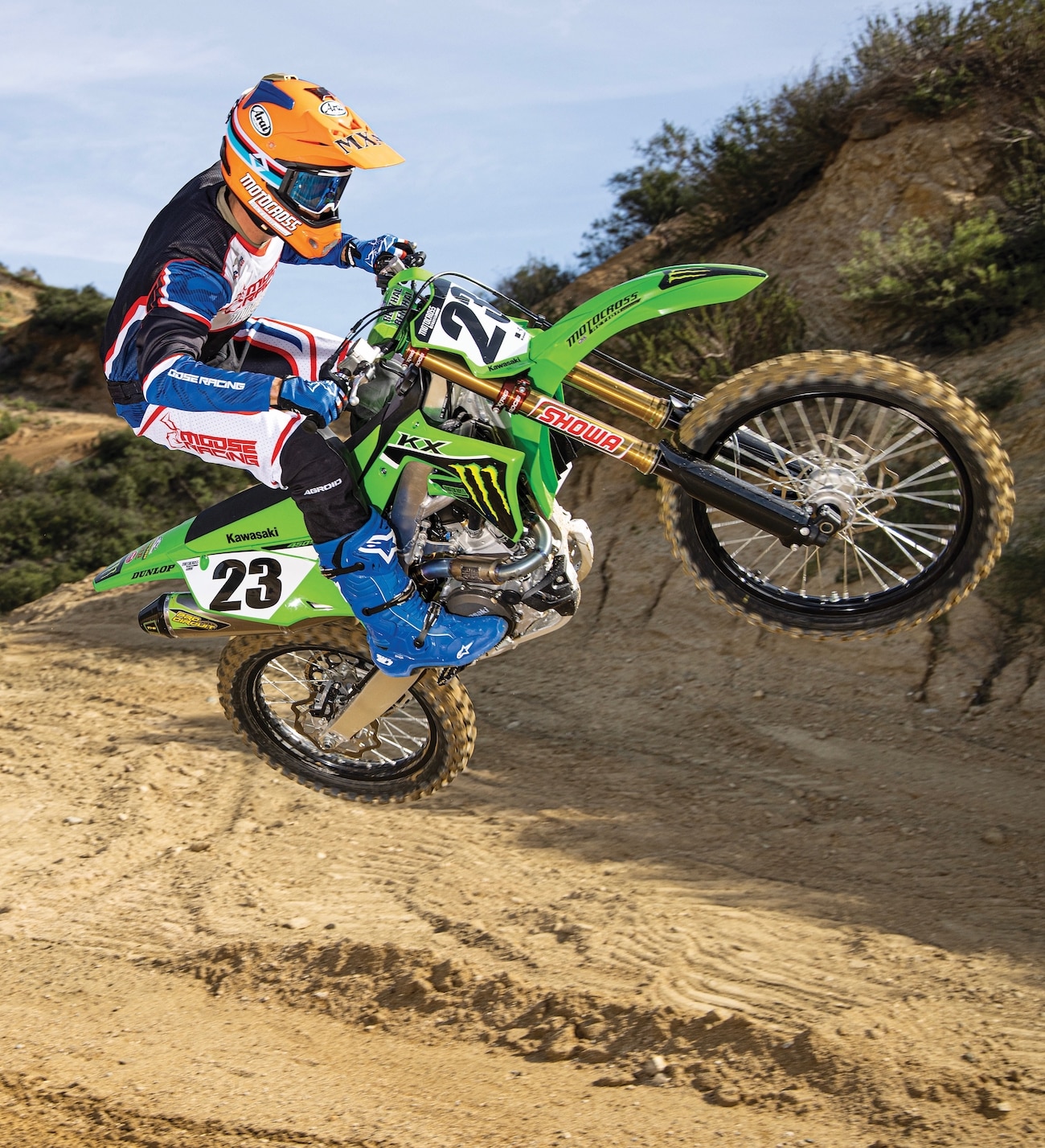



Comments are closed.